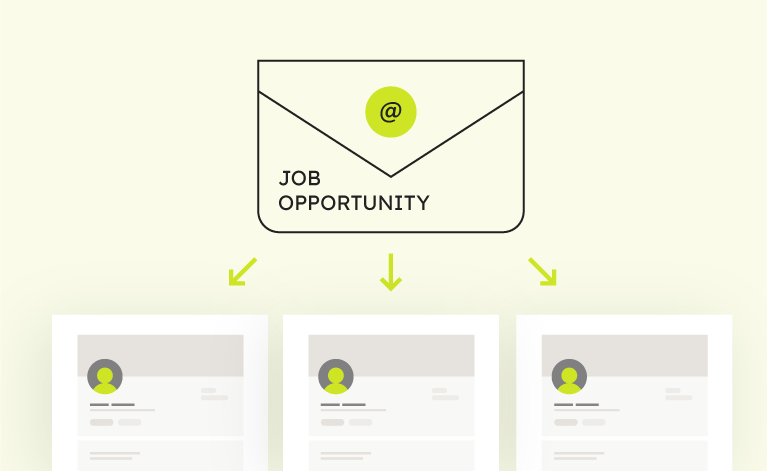Outbound recruiting: the weapon of choice for recruiters who don't rely on luck
Janis Kreilis

Attracting quality candidates to our job opportunities has become more challenging in recent years due to talent shortages. It’s forcing recruiting teams to rethink hiring processes and add new elements to the mix like creating employer branding programs and referral systems. While these important steps can set your company apart in the long run, inbound recruiting methods take time to bring in any tangible results. That’s why an increasing number of efficient recruiters are taking matters into their own hands through outbound recruiting - sourcing and reaching out to prospects themselves.
Why are recruiters looking outward?
With 75% of companies globally dealing with a talent shortage in 2022, up from just 34% a decade earlier, competition for skilled employees has skyrocketed. For many recruiting teams, this means a sharp drop in the quality of applications, increased recruitment costs, and a longer time to hire per role. Consequently, selecting the best candidates is no longer the main issue for many companies; it's attracting enough qualified candidates in the first place.
Alas, the future has nothing too encouraging to offer. For example, the global organizational consulting firm Korn Ferry's estimates reveal that over 85 million job openings will go unfilled by 2030, creating a talent shortage worth more than $8.5 trillion.
Well, if the candidates won't come to us, we'll just have to go looking for them. Turns out, this approach is twice as effective: according to Lever, only 1 in 152 inbound applicants get hired, while for sourced candidates this ratio is 1 in 72. So why is this the case?
1. Access to a much larger pool of passive candidates
Most people aren’t looking for a job…actively. Only about 30% of the global workforce is sending out resumes and actively seeking employment. At the same time, the remaining 70% are open to hearing out recruiters if presented with the right job opportunity. By limiting yourself just to job seekers, you're excluding a much larger pool of potential candidates.
2. More relevant candidates
When you’re reaching out to prospects yourself, you can pick them to closely resemble the type of person likely to succeed in the role, therefore improving the average candidate's quality or fit for the position.
3. Quick feedback
Unlike for inbound channels like Indeed where you typically have to wait a few weeks from the day you post your job ad before you can truly determine whether enough qualified candidates have applied, you'll know in a few days whether enough prospects are responding to your job opportunity when you are reaching out to them.
The same goes for examining the reasons in case your job ad isn’t getting the traction you expected. In outbound channels, you can test different variations of your ad and messaging simultaneously and see how prospects react to them thus gathering valuable feedback.
Strategic outbound recruitment
Although most recruitment teams do, in fact, dabble in outbound, often they do so only after when LinkedIn Jobs, Indeed, and other job board ads have failed to deliver enough qualified candidates.
While this approach might seem cheaper at first - after all, waiting for the applications to come in takes less effort than reaching out to prospects - the math changes when you factor in the costs to the company accruing while the role remains unfilled.
Therefore, unless you're at least 90% sure you'll be able to fill the role through incoming applications only, we'd advise to stop thinking of outbound as something you do when all else fails and instead strategically incorporate the process of sourcing and reaching out to prospects into your overall strategy. Here's what that shift may look like.

Extra work, great…
At a first glance, putting outbound recruitment at the center of your recruiting mix may seem like adding extra work. However, when we look at the benefits, it quickly becomes clear that instead of adding more sh*t to do, systematic outreach saves time and streamlines the entire process.
By sourcing prospects before creating a job ad, we can better understand our ideal candidates and their motivations, so we can begin to tailor job ads to meet their needs and increase the likelihood of positive responses. In outbound channels, we can also choose who we reach out to. By targeting close matches instead of screening unqualified candidates, we can spend our time much more productively.
More importantly, moving from a passive to an active role in recruiting allows you to create more predictable candidate pipelines, which can help you create smooth hiring processes and deliver results quickly, even in uncertain and changing labor markets.
Finally, outbound shifts your mind from a passive into a proactive mode. Instead of waiting for things to happen, you'll be making them happen. After hours of looking at worthless resumes and sending rejection emails, it may be just the thing to make you want to come to work again.
Know-how and technology to the rescue
Many of us started our careers in talent acquisition at a different era when the main hiring issue was simply selecting the right candidate. Quickly identifying, contacting, and pitching our job opportunities to a large number of qualified candidates may therefore not necessarily be a part of our skill set.
Fortunately, we don't have to reinvent the wheel. True, finding and reaching out to prospects used to be an enormously labor-intensive task. However, marketing and sales teams have been perfecting this art for decades and have already developed techniques to maximize the efficiency of outbound.
Plus, today's advanced search techniques help you find great prospects quickly, powerful messaging automation solutions speed up the outreach process without making you sound like a robot, and specialized outbound job ad tools (like Hyperjob 😸) let you stand out from the crowd without having to become a web designer. In other words, there's a tool or technology solution for every part of outbound recruiting, and they're only getting better, so you don't have to manually search for and contact prospects. You just need to know who you're looking for and what's important to them when considering job opportunities.
Become an outbound recruiting superhero
So the trick behind effective recruiting is actually changing your hiring processes from passive to more proactive. You may have to learn some new things, but with modern tools and tried-and-tested techniques borrowed from marketing, you can still create predictable talent pipelines and manage streamlined recruiting projects, even in the face of a massive talent shortage that's only expected to get worse.
If you're ready to explore the world of outbound recruiting, check out Hyperjob - a platform designed to streamline the entire outbound recruiting process, from creating job ad microsites optimized for conversion in outbound recruitment to sourcing candidates and managing your talent pipeline.
To help you get started on your outbound recruiting journey, we've also written our guidebook for efficient recruitment in 2023, which explains different outbound methods in detail and sets you on the path to successful talent acquisition. Check it out here and let us know what you think.






